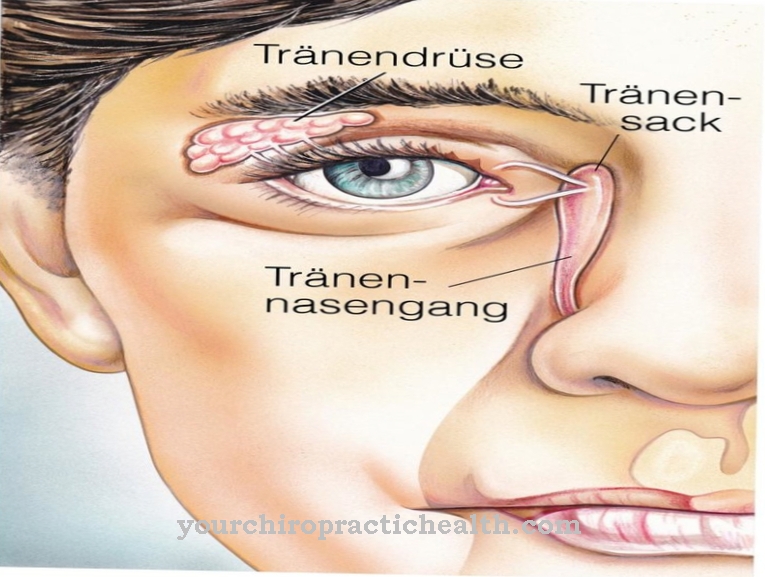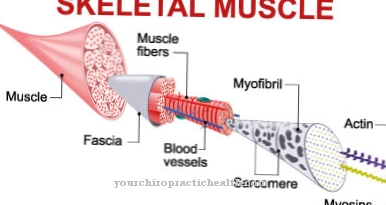With the intestinal Fructosintolerance it is an intolerance of fructose (intestinal means that the disease affects the digestive tract, fructose is fructose, intolerance means something like intolerance). It manifests itself primarily in digestive problems.
What is fructose intolerance?

© astrosystem - stock.adobe.com
Fructose intolerance is a digestive disorder in which fructose from food cannot be sufficiently absorbed in the intestine (malabsorption) and causes discomfort in the colon.
In Germany, around one in ten people is affected by fructose intolerance; the incidence of frutose malabsorption is estimated at around a third of the population.
There is also a hereditary form of fructose intolerance, which is due to a genetic enzyme defect; However, this is extremely rare and clearly distinguishable from the much more common intestinal fructose intolerance.
causes
In intestinal fructose intolerance, there is initially fructose malabsorption. Due to a malfunction of certain transport proteins, fructose cannot be completely absorbed in the small intestine and so it reaches the large intestine in large quantities.
This malabsorption is not uncommon in and of itself and is unlikely to have any disease value. An intestinal disorder specific to fructose intolerance leads in the second step to the fact that the fructose present in the large intestine leads to digestive problems. Diarrhea, gas and abdominal pain develop. The exact mechanism that leads from fructose malabsorption to fructose intolerance has not been conclusively clarified.
The influence of stressors such as the use of antibiotics or hormone fluctuations on the development of fructose intolerance is discussed, but has not been adequately proven.
Symptoms, ailments & signs
Symptoms of fructose intolerance occur that can also occur with other diseases. As a result, it often takes a long time to make the correct diagnosis. The typical symptoms appear immediately after consuming a meal containing fructose. This leads to strong gas formation in the intestine, flatulence, diarrhea, abdominal pain, nausea, vomiting and colicky cramps.
Furthermore, tiredness, headaches, dizziness, increased susceptibility to infections, sensitivity to the weather and depression often occur. Gas formation and flatulence are based on the decomposition processes of fructose that is not absorbed by the intestine. In the case of hereditary fructose intolerance, which occurs less frequently, the fructose is absorbed by the intestine, but cannot be sufficiently broken down.
The resulting increase in the fructose concentration in the blood displaces the glucose. This can lead to dangerous hypoglycaemia, impaired consciousness and impaired liver function. The affected infants therefore suffer from failure to thrive without a strict low-fructose diet. However, around 30 percent of all patients are completely symptom-free.
Why it comes to the different manifestations has not yet been fully clarified. However, some possible secondary symptoms of fructose intolerance are known. These include damage to the intestinal mucosa, disruption of the intestinal flora, weakening of the immune system, and folic acid and zinc deficiencies.
The damage to the intestinal mucosa can lead to further intolerances such as lactose intolerance and histamine intolerance. The disturbance of the intestinal flora becomes noticeable through frequent diarrhea or constipation as well as other digestive disorders. Folic acid deficiency is often the cause of depression, irritability and difficulty concentrating.
Diagnosis & course
Fructose intolerance initially manifests itself in digestive complaints such as diarrhea or constipation, pain and cramps in the intestinal area, as well as gas and bloating.
Untreated fructose intolerance can also lead to irritable bowel syndrome and heartburn. The impaired absorption of nutrients from the intestine can lead to severe tiredness and exhaustion up to depression and a general weakening of the immune system. Often there is a lack of zinc, folic acid and tryptophan.
The diagnosis of fructose intolerance can be made by a simple hydrogen breath test. The concentration of hydrogen in the breath is measured before and after the intake of fructose. An increased concentration indicates the presence of fructose intolerance. Alternatively, it is also possible to measure the fructose plasma level in the blood.
Complications
Complications rarely occur with the common form of fructose intolerance. These are to be expected above all when fructose is consumed in large quantities despite the already recognized intolerance. The situation is different with congenital - the so-called hereditary - fructose intolerance. This already affects babies.
This innate defect in fructose metabolism is potentially dangerous and life threatening. The enzyme-related intolerance of fructose can lead to a whole range of health complications. These are caused by the consumption of even the smallest amounts of fructose. As a countermeasure, a strict, low-fructose diet must be followed for life. The reason: the congenital enzyme deficiency slows down the breakdown of fructose.
A common complication of congenital fructose intolerance is sugar metabolism disorders. With hereditary fructose intolerance, the risk of hypoglycaemia is particularly high. In the worst case, hypoglycaemia can lead to impaired consciousness and a coma. Often there is an over-acidification in the body, so that there is a metabolic derailment.
At the same time, the slower breakdown of fructose produces metabolic products that damage the liver, kidneys and intestinal mucosa. This leads to kidney dysfunction up to acute kidney failure or liver dysfunction. Liver cirrhosis can also develop. In addition, hereditary fructose intolerance can lead to coagulation disorders.
When should you go to the doctor?
If a digestive disorder recurs shortly after eating, a doctor should be consulted. If you have flatulence, pain in your abdomen or stomach, a feeling of pressure inside your body or if you have heartburn, a doctor's visit is necessary. Persistent malaise, nausea, vomiting, or high body temperature should be examined and treated by a doctor. If the person concerned suffers from a vague feeling of illness, general weakness or impaired concentration, he needs medical help.
Reduced performance, fatigue and persistent tiredness should be discussed with a doctor. If diarrhea, constipation, or urination irregularities occur, the symptoms should be presented to a doctor. If the symptoms persist for several days or weeks, this is considered unusual and they should be clarified by a doctor. If there are changes in the skin's appearance, if itching occurs or if open wounds appear, a doctor must be consulted.
Pathogens can enter the organism through the wounds and cause further diseases. A doctor should be consulted if there is a lack of attention or inner restlessness. If emotional or mental problems arise, it is necessary to consult a doctor or therapist and ask for help. In the case of depressive moods, withdrawal behavior or aggressive behavior, a visit to the doctor is necessary.
Doctors & therapists in your area
Treatment & Therapy
Since the exact mechanisms of fructose intolerance have not yet been clarified, there is no causal or curative therapy. The only form of treatment is to avoid foods containing fructose.
This is not without problems, as fructose occurs more and more in foods that are considered beneficial for a healthy diet (fruit, some vegetables, but also numerous diabetic and light products). In addition, fructose is increasingly being used in industrially produced and heavily processed foods, especially as a sweetener. Ordinary table sugar also consists of half fructose.
For this reason, professional nutritional advice is recommended. If the intake of fructose is reliably reduced, the symptoms usually improve noticeably and patients can usually live symptom-free if the appropriate diet is adhered to.
How strictly this diet has to be adhered to or what amounts of fructose can still be tolerated without symptoms, varies greatly from person to person. A dietary supplement called fructose is also available from hianus, which converts the fructose in the intestine into glucose when foods containing fructose are ingested, thus preventing the intolerance reaction.
Fructose intolerance is often associated with lactose intolerance, which also has similar symptoms. An additional check of the tolerance of lactose is therefore recommended for all patients with fructose intolerance.
Outlook & forecast
The prognosis is different for the three known forms of fructose intolerance. Acquired intestinal fructose intolerance, or fructose malabsorption, is a treatable metabolic problem. This is due to intestinal dysbiosis. Intestinal dysbioses can be successfully treated with appropriate measures.
The prognosis is positive. But it can take longer for the intestinal flora to regain balance. The chronic strain on the intestine must be eliminated and the intestinal flora rebuilt. Then you can test which amounts of fructose can be tolerated. Usually small amounts of fructose are tolerated.
With the prognosis of fructosemia, the prognosis is also positive. The failure of an enzyme called fructokinase, which is present in the liver, is rarely noticed. The fructose accumulates in the blood. It is excreted in the urine. In this respect, there is no harm to health.
In the congenital and rarely occurring hereditary fructose intolerance (HFI), there is a deficiency in the enzyme fructose-1-phosphate aldolase B. This form of fructose intolerance can manifest itself with severe effects. If this disorder is not treated promptly, liver and kidney damage are the result. It can lead to dangerous hypoglycaemia.
To protect infants from the effects of hereditary fructoseone tolerance, they should only receive breast milk for the first six months of their life. The sooner the waiver therapy begins, the less consequential damage there is to be feared.
prevention
As the exact genesis of fructose intolerance has not yet been clarified, there are no indications of possible preventive measures. It is only possible to avoid potential consequential damage from a previously diagnosed fructose intolerance (such as deficiency symptoms or irritable bowel syndrome). This requires a well-thought-out diet that supplies the body with all the necessary nutrients, but avoids the fructose that causes symptoms. For this purpose, a balanced diet plan should be created with a nutritionist.
Aftercare
Fructose intolerance should always be monitored. Affected individuals should follow the doctor's instructions and advice. A person suffering from this disease cannot consume certain foods. For this reason, a food diary specially tailored to the person is created.
This diary records all foods that the person should not consume. Specific nutritional advice is also a good option for a fructose intolerant person. The professionals who are perfectly familiar with nutrition and intolerance can help best in this case.
It is important that those affected adhere to the nutritional plans that have been put together, otherwise dangerous complications can arise. Serious diarrhea can develop after eating incompatible food. Another very dangerous complication is the allergic reaction.
With this, the patient threatens to suffocate, as the mucous membranes swell and the face evaporates. In summary, follow-up care and the associated control of the food consumed should always be observed and monitored by those affected in order to avoid late effects and alleviate the symptoms.
You can do that yourself
Immediately after diagnosis, patients should seek advice from a nutritionist. This provides information on how those affected should plan their diet initially and in the long term. In this way, a nutrient deficiency due to fructose intolerance is prevented. The change in diet is divided into three phases and is documented with the help of a food diary.
In the course of the first phase, foods that are high in fructose should be avoided. It is advisable to avoid apples, pears, mangoes, grapes, dried fruits, honey, fruit and vegetable juices. In addition, no food should be consumed that has table sugar added. The consumption of chewing gum, sugar-free sweets and diabetic products must also be restricted as far as possible.
These contain the sugar substitutes xylitol, sorbitol and mannitol, which hinder the absorption of fructose from the intestine. In addition, those affected should not consume foods that have a flatulence effect. This phase should take up a period of two to four weeks and is aimed at reducing the symptoms.
The subsequent second phase is classified as a test phase. This should cover a period of six weeks. The focus of this phase is on expanding the selection of foods that should be accompanied by a moderate intake of fructose. Consequently, the consumption of compatible fruits, such as bananas and apricots, must be increased. It is also advisable to eat relatively more vegetables than fruit. In addition, carbonated drinks, types of cabbage, citrus fruits and whole grain products should be tested for their tolerance.
The goal of the following third phase is the permanent freedom from symptoms of the respective patient. Accordingly, all individually compatible foods can be consumed in the long term. The long-term diet should be characterized by variety and balance. In addition, care must be taken to ensure sufficient fluid intake. Furthermore, new foods should be constantly tested for their individual tolerance, as the fructose absorption capacity is often improved again.
Meals should be taken more often, but in smaller portions. This relieves both the stomach and the intestines. Furthermore, fruit should not be eaten pure. Accordingly, fruit should either be consumed with a meal, in the form of a dessert, or together with dairy products. The combination of fat and protein leads to a slower absorption of the fructose.



.jpg)


.jpg)

















.jpg)



